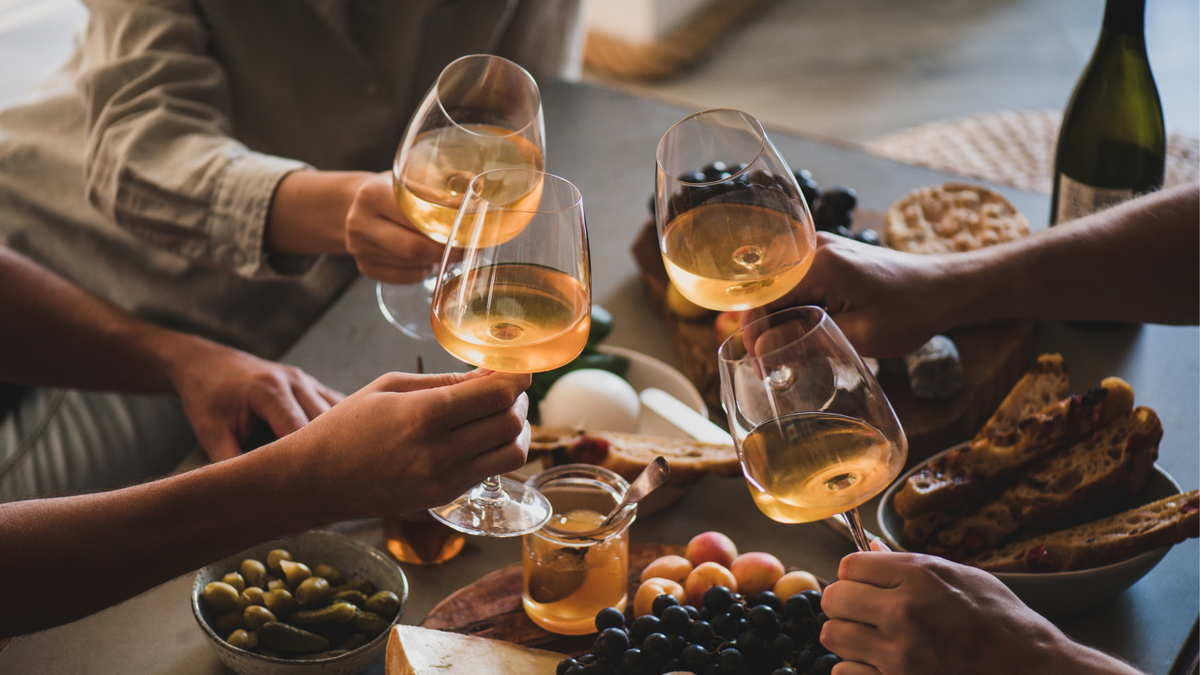Red or white – or maybe rosé? It’s a question most of us have mulled over countless times while perusing a wine list. But now there’s a fourth option to consider: no longer confined to trendy bars and independent shops, orange wine is having a moment.
Online supermarket Ocado announced sales of the amber-hued wine have shot up 99% year-on-year across the UK, with a 435% month-on-month rise in London alone, reported Mina Holland in The Guardian . Back in March, the launch of Aldi’s ‘Rosorange’ hybrid of rosé and orange wine went viral on TikTok, seeing 5,000 bottles “fly off the shelves” in the first week alone as influencers raced to crown it the “drink of the summer”.
Despite the name, orange wine isn’t made from oranges. In fact, it isn’t even always orange. Its colour can range from “pale yellow to luminescent orange”, according to Lauren Eads in Decanter . How is it made? Essentially, it’s a “white wine made in the style of a red, in contact with the skins”. This means it has more tannins, giving it a darker tinge and fuller body.
Subscribe to The Week
Escape your echo chamber. Get the facts behind the news, plus analysis from multiple perspectives.
SUBSCRIBE & SAVE
Sign up for The Week’s Free Newsletters
From our morning news briefing to a weekly Good News Newsletter, get the best of The Week delivered directly to your inbox.
From our morning news briefing to a weekly Good News Newsletter, get the best of The Week delivered directly to your inbox.
While sales have soared recently, it’s actually a method of winemaking that dates back to places such as ancient Georgia, said Will Lyons in The Times, when “all the grapes were thrown together and left to ferment in terracotta amphoras”.
A note here from Eads: “Don’t confuse ‘orange’ with ‘natural'”. Yes, orange wines are closely associated with the natural wine movement, but they’re not always made using organic grapes. If this is important to you, remember to check the label and look into the producer.
The intense, complex flavour makes orange wines ideal for pairing with a variety of foods. Victoria Moore in The Telegraph advised matching them with seasonal dishes that balance notes of sweetness with herbs and spices: “it’s no coincidence” that when Middle Eastern flavour guru Yotam Ottolenghi launched his own wine range, one of them was an orange wine.
Georgia, Italy, France and Romania are among the most popular orange winemaking countries, but England and Wales are also seeing a wave of talented producers crop up. With sales showing no signs of abating, here are five bottles to try this summer.
Denbies Wine Estate in Surrey is one of only a handful of producers to achieve net zero globally
(Image credit: Alamy)
Winzer Krems ‘Orange’ Grüner Veltliner 2021/22, Austria
This cooperative of almost 800 growers produces exceptional wines at Winzer Krems on the banks of the river Danube, around 40 miles from Vienna. The Grüner Veltliner is a stand-out bottle, expertly balancing notes of ginger, honey and pepper. “Golden, slightly spiced and aromatic, this is a strong-legged wine that can stand up to spicy food,” said Holland.
£11.99, majestic.co.uk
Domaines Paul Mas Rosoranges 2022, France
Wood recommended this “easy-drinking rosé orange hybrid” made from a blend of organically grown red and white grapes at the Domaines Paul Mas estate in the Languedoc region of France. The unique wine is ideal served as an aperitif or with soft cheese.
£12.50, vintageroots.co.uk
Naranjo Torontel Loncomilla Maturana 2022, Chile
This vibrant wine is painstakingly crafted in small quantities at a winery in Loncomilla, a remote region of the Maule Valley in Chile. Crafted from the pinkish skins of torontel grapes, it has a golden-yellow hue and “tangy zip” with floral flavours of potpourri, said Lyons.
£15.95, corneyandbarrow.com
Gérard Bertrand Orange Gold 2021, France
Lana Bortolet in Forbes recommended this bottle from renowned biodynamic producer, Gérard Bertrand. The wine blends a specially selected mix of grapes (primarily grenache and muscat) which are hand-picked, vinified and fermented in whole bunches for around two weeks. Excellent with curry dishes, it’s “full-bodied and complex, smacking of tangerine, melon and spices”.
£18.50, vinvm.co.uk
Denbies Wine Estate Orange Solaris 2022, England
One of only a handful of wineries to achieve net zero globally, this family-run estate in Surrey is among England’s largest vineyards. Solaris grapes are fermented for up to four months to make this apricot-hued wine, which “looks like a white wine but has tannins and complexity associated with a red”, according to Eads. Expect notes of baked apple and stone fruits.
£27.49, grapebritannia.co.uk

